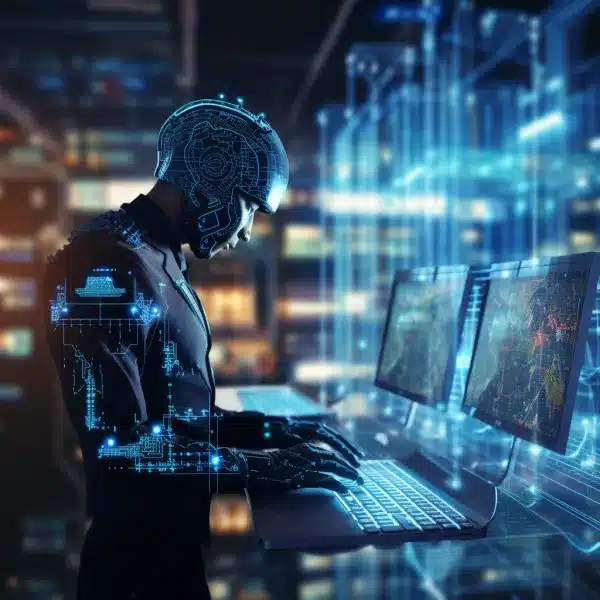
AI and Cybersecurity: Battling the Dark Side of Technology
AI In Cybersecurity: Artificial Intelligence (AI) has become an integral part of our lives, transforming numerous industries with its ability to process vast amounts of data and make informed decisions. However, as AI continues to evolve, so do the threats it faces. Cybersecurity has emerged as one of the foremost concerns in this digital age, with hackers and malicious actors constantly innovating to exploit vulnerabilities.
AI, with its immense potential, offers promising solutions to combat the dark side of technology it contributed to. By leveraging the power of AI, cybersecurity professionals can enhance their ability to protect individuals, organizations, and even nations from cyber threats.
The Role of AI in Cybersecurity

AI technology enhances cybersecurity efforts in several ways:
1. Threat Detection: AI’s advanced algorithms and machine learning models can analyze massive amounts of data to detect anomalies and patterns indicative of cyber attacks. It helps in identifying and preventing potential threats before they can cause significant damage.
2. Real-Time Monitoring: AI-powered systems can continuously monitor network traffic, recognizing unusual activities and swiftly responding to potential breaches.
3. Cyber Defense: By employing AI-driven defense mechanisms, systems can autonomously respond to threats, actively preventing unauthorized access and mitigating attacks.
Challenges and Limitations
Although AI brings significant benefits, it also faces challenges and limitations:
1. Adversarial Attacks: Hackers can exploit vulnerabilities in AI systems, training them to make wrong decisions. This poses a significant threat as even intelligent systems can be manipulated.
2. Limited Learning: AI models learn from historical data, which means they struggle with emerging threats that lack historical patterns. Constant updates and fine-tuning are necessary to counter new cyber attacks.
3. Ethical Concerns: Developing AI that respects privacy and adheres to ethical guidelines is crucial. The potential misuse of AI in cyber warfare and surveillance raises concerns that must be addressed responsibly.
Collaboration for a Safer Future
To combat the dark side of technology effectively, collaboration among AI developers, cybersecurity experts, and policymakers is essential. Close cooperation will enable the development of robust AI-driven cybersecurity solutions that can stay ahead of evolving threats.
“The battle between AI and the dark side of technology demands collective efforts and a proactive approach.”
Investment in research and development, knowledge sharing, and the establishment of global cybersecurity standards are critical steps towards a safer digital landscape. Governments and organizations must allocate resources to foster innovation and create a skilled workforce capable of understanding and countering emerging threats.
In Conclusion
AI is a powerful tool that can revolutionize cybersecurity, helping us counter the ever-growing threat landscape. However, it is vital to recognize the challenges and limitations associated with AI’s use in cybersecurity. Combining the strengths of AI technology with human expertise and ethical considerations will pave the way towards a safer digital future.
“The ongoing battle against cyber threats requires the continuous evolution of AI and commitment to proactive defense strategies.”
What are the key strategies and approaches employed by AI systems to combat the dark side of technology in the realm of cybersecurity?
AI systems employ several key strategies and approaches to combat the dark side of technology in the realm of cybersecurity. Some of these include:
1. Anomaly detection: AI systems use machine learning algorithms to analyze large amounts of data and identify abnormal patterns or behaviors. By detecting anomalies, they can identify potential cyber threats or attacks.
2. Behavioral analysis: AI systems can learn and understand the normal behavior of users, devices, or networks. By continuously monitoring and analyzing behavior, they can detect any deviations that might indicate a cybersecurity incident.
3. Threat intelligence: AI systems can gather and process a vast amount of threat intelligence data from various sources such as security feeds, forums, and dark web. By proactively analyzing this data, they can identify emerging threats and vulnerabilities.
4. Automated response and remediation: AI systems can swiftly and automatically respond to cyber threats. They can execute predefined actions to mitigate or contain the impact of an attack, such as isolating affected systems or blocking suspicious activities.
5. User behavior analytics: AI systems can analyze user behavior to detect any unusual or suspicious activities. By monitoring user actions, they can identify potential insider threats or unauthorized access attempts.
How effective is the integration of AI in cybersecurity measures, and what are the potential limitations or challenges it may face?
However, there are several potential limitations and challenges associated with the integration of AI in cybersecurity:
1. Adversarial attacks: Hackers can leverage AI technologies to develop sophisticated attacks that evade detection systems. They can manipulate or deceive AI algorithms and exploit vulnerabilities in models, leading to false positives or negatives.
2. Lack of Explainability: AI algorithms, particularly deep learning models, can be complex and difficult to interpret. This lack of explainability makes it challenging to understand how and why certain decisions or predictions are made, limiting the trust and acceptance of AI systems.
3. Data bias and privacy concerns: AI models require large amounts of data for training. If the training data is biased or incomplete, it may result in biased outcomes or limited accuracy. Additionally, the use of personal and sensitive data for AI analysis raises privacy concerns and regulatory compliance issues.
4. Skill gap and dependence: Implementing and managing AI-powered cybersecurity systems require specialized knowledge and skills. There is a shortage of cybersecurity professionals with AI expertise, and organizations may become overly reliant on AI systems, neglecting the need for human expertise and critical thinking.
5. Ethical considerations: AI technologies raise ethical concerns regarding the potential misuse of power and invasion of privacy. Decision-making processes automated by AI may have unintended consequences or discriminatory outcomes.

How is artificial intelligence being utilized to address cybersecurity threats and vulnerabilities in today’s technological landscape?
AI is being utilized to enhance human capabilities and improve security measures to combat cybersecurity threats and vulnerabilities. Here are some ways AI is used:
1. Real-time threat detection and analysis: AI systems can find patterns and anomalies in massive data sets, indicating potential threats or assaults. Analyzing network traffic, user behavior, and system logs helps identify and respond to cyber threats fast.
2. Intrusion detection and prevention: AI-powered systems detect abnormal network behavior and alert for potential intrusions, allowing for real-time response and threat prevention.
AI allows for the development of behavioral biometrics models, which track user activity to detect anomalous patterns that may suggest illegitimate access. Anomalies in typing habits, mouse movement, or navigation behavior can indicate possible risks.
4. Phishing and fraud prevention: AI algorithms examine emails, webpages, and communications to discover phishing attack trends. AI can detect dangerous material, URLs, or attachments using Natural Language Processing (NLP) and warn users or block access to malicious links.
AI can automate vulnerability scanning, discovering security flaws in systems or software, and suggesting fixes or mitigation techniques. It helps enterprises proactively safeguard their infrastructure and remediate any vulnerabilities before they are exploited.
6. Improved user authentication and access control: AI can use biometric data like facial or voice recognition for more secure authentication than passwords. Continuously learning AI systems can adapt to user behavior for more accurate authentication.









Thanks for sharing. I read many of your blog posts, cool, your blog is very good.
I like this web blog very much, Its a really nice situation to read and obtain info.Blog range